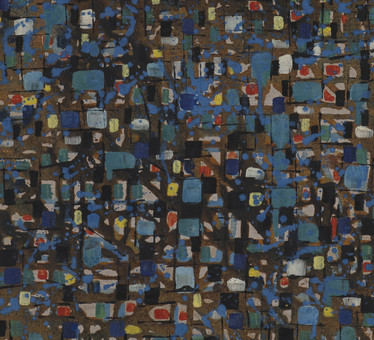Antônio Bandeira

Fortaleza, Brazil, 1922 —
Paris, France, 1967
In Antonio Bandeira’s work, informal abstraction is structured based on exemplary constructive rigor: a lively rhythm leads the observer’s gaze and feeling towards a rich internal order to compose and decompose right there, in the apparent chaos pictorial that expresses the painter’s plastic strength.
Born in Fortaleza, in 1922, Bandeira carried out his first studies in drawing and painting on a self-taught basis. Engaged in the renovation of the local art scene, he founded in 1941, together with the artists Mário Baratta, Raimundo Cela and Aldemir Martins, the Centro Cultural de Belas-Artes (CCBA), where he presented his first exhibition in 1943. After a brief period living in the Rio de Janeiro, in 1945 Bandeira received a scholarship from the French Embassy and moved to Paris the following year. From then on, a fruitful and long relationship between the artist from Ceará and the French capital begins. The constant contact with postwar Parisian avant-garde artists like Georges Mathieu, Camille Bryen and Wols, reflected decisively in the work of the painter, who naturally moved away from the expressionist figurative aesthetic in favor of abstract language. The work Natividade (1949) dates from that time, in which figures such as trees, houses and a staircase that establishes the vertical axis of the canvas lose their definition and meaning, fragment into the triangular mesh and the rain of color like the royal sun. red, from Ceará, remains unscathed.
Thus, among the works of the 1950s there are landscapes organized by horizontal and vertical linear schemes interspersed with stains, spatulas and splashes of paint that, despite keeping the spontaneity of the gesture, are inserted in a cadenced composition that usually directs towards the center the focal point of tensions, strikes and resolutions of the mobilized plastic forces on the screen. However, keeping in the title of the works a representational semantic entry, Bandeira expresses his desire to preserve a referential relationship with nature, with the materiality of the world. The result of this research is the delineation of expression as a pictorial decantation of the world from the artist’s interiority, something that can be seen in works such as London Houses (1955), The Tree (1955) and The Great City (1957).
The worlds shaped by Antonio Bandeira, at the same time ephemeral, shuffled or explosive, but with remarkable structural strength and tendency, awaken the observer to the intimate process of self-discovery and diving into the confluence of perception with the psyche.
GGS